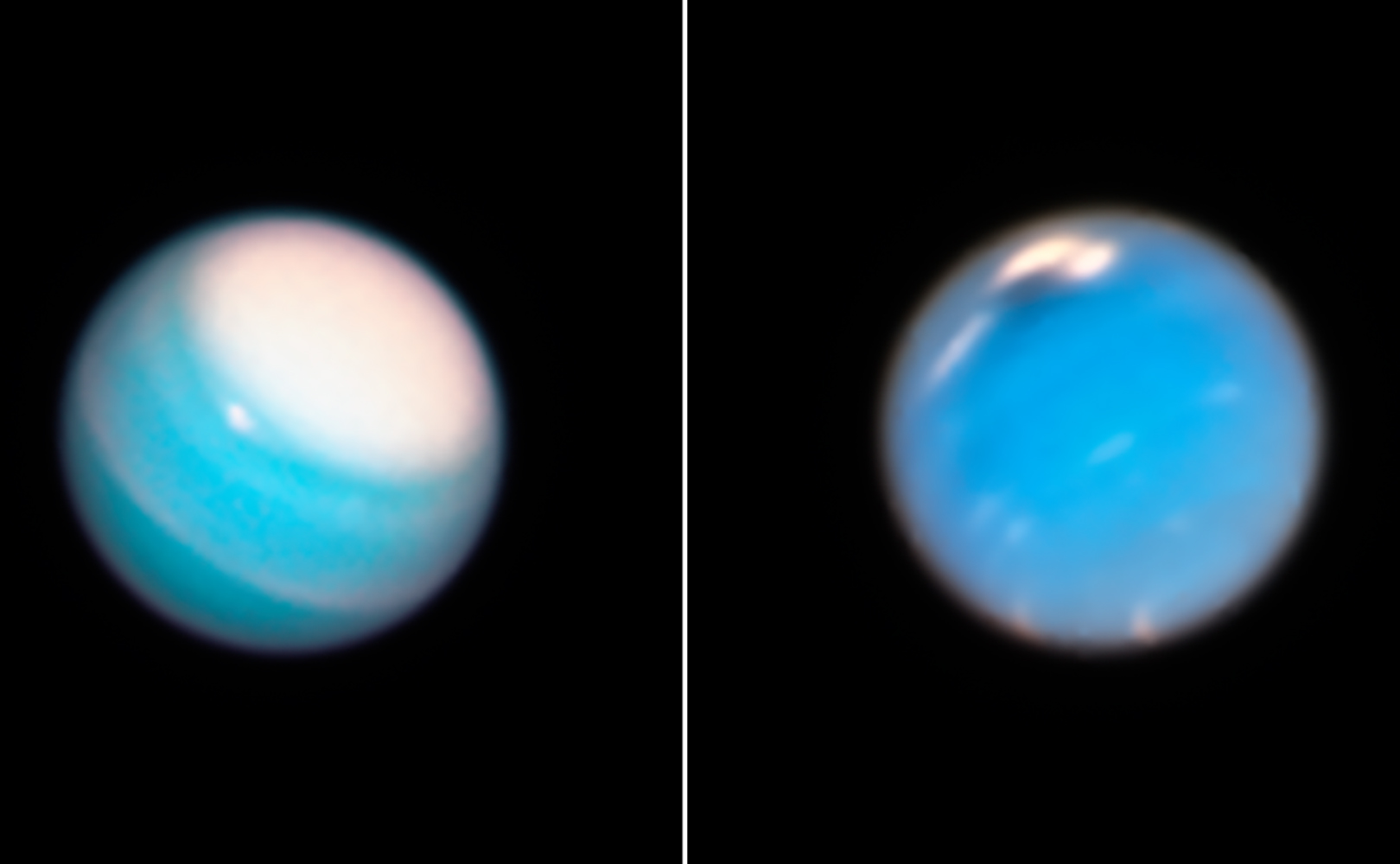The ice giants, as we commonly call Uranus and Neptune, are the least known planets in the solar system. Only Voyager 2 has visited them in person in more than 30 years. As it turns out, we may know them less than we previously thought.
The unusual planets orbiting Uranus and Neptune are the only planets in the solar system (assuming we no longer treat Pluto as a planet) that were not known in ancient times. The reason is very simple. Uranus is an object within the sensitivity of the human eye, and Neptune is virtually imperceptible even in ideal weather conditions. In addition, these planets are very far from the Sun and their movement across the sky is not as striking as the closer planets. People who saw Uranus in ancient times did not realize it was a planet because it blended into the background of many stars surrounding it.
Neptune is currently in the daytime sky, which means it lies behind the Sun. Uranus, in turn, can be seen at sunset directly above Jupiter on the western horizon. (Image: Stellarium)
William Herschel discovered Uranus in 1781, the first planet to be discovered using a telescope. It then turned out that its movement in the sky did not match the calculations, and another planet located outside the orbit of Uranus was suggested as the culprit. This was a triumph of perturbation calculus then, which has now become very useful in determining the orbits of various celestial bodies in the solar system. The hypothetical planet became real thanks to Johann Galle, who discovered it (convinced by research by Urbain Le Verrier) in 1846.
The orbits of the planets Mars, Jupiter, Saturn, Uranus, and Neptune. Map created before Pluto was considered a dwarf planet. (Image: NASA)
Galle was not the first astronomer to observe Neptune, but previously the lack of information about the existence of such a planet led observers to classify Neptune as an ordinary star. This is what Galileo, among others, did, as his telescope was able to show Neptune. Initially, the names Uranus and Neptune were not accepted by a wide circle of astronomers. Before the discovery of the last planet, there were also names derived from nicknames or other references to mythology than those currently accepted.
Images of Uranus taken from Earth by the VLT telescope. The figure on the left, before adaptive optics, shows how much observational technology has changed. (Image: European Southern Observatory)
Uranus and Neptune – the age of ice giants
Both planets are several times larger than Earth. Neptune has a greater mass than Uranus, but it is slightly smaller. In literature, the planets have been depicted as being significantly different in appearance. Uranus is pale blue and has almost invisible structures on the surface, the upper cloud ceiling. Neptune had a sharper appearance, dark blue with noticeable cloud bands and a large dark spot, reminiscent of an atmospheric phenomenon seen on Jupiter.
This view of the appearance and internal structure of both planets, which posits that they have a rocky or icy core surrounded by an ice cap and an atmosphere of hydrogen and helium on the outside, is based on observations in the second half of the planet. The twentieth century, as well as data collected by the Voyager 2 probe, which was the only one to visit both planets, take close-up pictures of them, and discover many additional rings and moons.
Because the aforementioned ice, as well as proposed ionic water (a state in which water molecules split into ions), make up a significant portion of the planet's mass, they are referred to as ice giants, as opposed to gas giants like Jupiter. And Saturn (there are also theories that Saturn is a failed gas giant).
The true colors of Uranus and Neptune based on a new analysis of images from Voyager 2. (Image: Patrick Irwin, University of Oxford)
The above views on both planets have recently been put to the test. First, at the beginning of 2024, knowledge about the appearance of the two planets was verified. It turns out that images from Voyager 2, as well as those taken by the Hubble telescope, were incorrectly processed, resulting in the aforementioned strong contrasts and blue saturation.
In fact, Neptune is visually very similar to Uranus (as shown above). Although it has lost its effectiveness, it has not become less interesting, because it now turns out that not only the appearance, but also the structure of both planets may have been misunderstood until now.
How do we know how planets are built inside?
This is something that is as fascinating as it is mysterious to a layperson unfamiliar with research techniques. On Earth and Mars, as well as on the Moon, seismic data are a great help. For other planets, gravity and magnetic field measurements are also used, as well as data from observations of the outer composition.
In the case of the Earth, we can assume its internal structure with a great deal of certainty, because we have more than enough seismic measurements. In the case of the Moon, new data indicating a different structure than before have recently been obtained thanks to the analysis of data from seismometers. Seismic data recently collected by the In Sight probe has also allowed us to create the most accurate model of the planet's interior.
Generally accepted models of the internal structure of Uranus and Neptune. Two different types, with sharp boundaries between layers of material and a mixed composition (bottom). (source: SpringerLink)
But what about gaseous planets? Here, gravity and magnetic field measurements by orbiters are also useful, but theoretical models are very important. With the advent of the computer age, numerical modeling has become a very important part of astronomy. Today, thanks to tremendous advances in computational efficiency, we can generate hundreds of thousands of models of internal structure in a reasonable time (much less than a scientist's entire career) and identify the most likely ones.
This is where the fun begins. Because the current model of the ice giant, which, according to some estimates, contains tens of thousands of times more water than Earth, does not best reflect reality. According to the authors of the new analysis of the internal structure of Uranus and Neptune, previous research has overlooked the most important thing: knowing what happened when these planets formed.
Uranus and Neptune – their internal structure and composition are different than expected
We know that in the young solar system, when Uranus and Neptune formed from the dust cloud surrounding the Sun, their increased gravity attracted many comet-like planetesimals. This led, according to some evolutionary models, to the migration of previously narrow orbits, and it is even possible that Neptune was initially closer to the sun than Uranus.
Uranus and Neptune. Infrared observations taken by the Webb telescope. (Image: NASA/Web)
The problem of planet formation in the previously accepted way, which leads to abundant water ice, arises from the fact that according to the latest knowledge, planetesimals should be abundant in carbon or its compounds, not in ice. The leader of the team that created a new model for the structure of Uranus and Neptune – Uri Malamud – is trying to explain this contradiction, that is, answer the question of how an ice giant can form when the building blocks do not contain enough elements. Necessary components.
For this purpose, various models of the internal structure were created, which, in addition to water, also included methane. This has already been taken into account as a component of Uranus and Neptune, because it occurs in the planets' atmospheres, but to a very small extent.
The new model for the internal structure of Uranus and Neptune assumes the presence of a methane-rich atmosphere located below the planet's atmosphere. Its mass may constitute a large fraction of the planet's mass.
The models that turned out to be most consistent with reality were those that did not deny the existence of a layer of water forming the mantle, but added another element. A type of additional outer mantle, which may amount to 10 to 20% of the planet's mass (depending on the model), which is composed of frozen methane. Incidentally, the proposed chemical reactions in the planet's interior that led to the formation of methane are also responsible for the presence of water.
As you can see, not only exoplanets can be mysterious. Uranus and Neptune are proof that our planetary system as a whole is still largely unknown. The final answer to the question “How was each of its components created?” Perhaps this can only be achieved through comprehensive exploration with the help of tentacles. This will take time or advances in interplanetary propulsion technologies if we want to get initial results faster than a few generations.
Source: space.com, arxiv, info. king

Echo Richards embodies a personality that is a delightful contradiction: a humble musicaholic who never brags about her expansive knowledge of both classic and contemporary tunes. Infuriatingly modest, one would never know from a mere conversation how deeply entrenched she is in the world of music. This passion seamlessly translates into her problem-solving skills, with Echo often drawing inspiration from melodies and rhythms. A voracious reader, she dives deep into literature, using stories to influence her own hardcore writing. Her spirited advocacy for alcohol isn’t about mere indulgence, but about celebrating life’s poignant moments.










